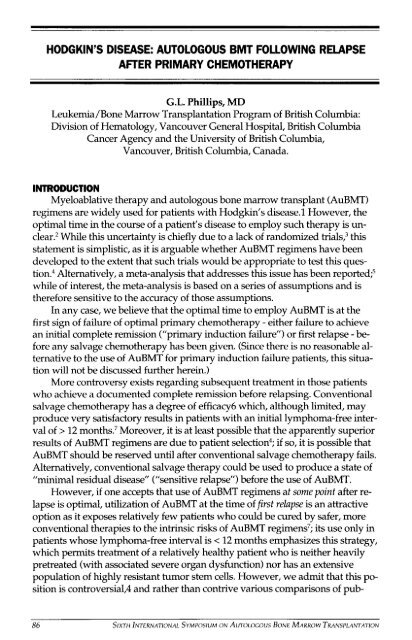VI Autologous Bone Marrow Transplantation.pdf - Blog Science ...
VI Autologous Bone Marrow Transplantation.pdf - Blog Science ...
VI Autologous Bone Marrow Transplantation.pdf - Blog Science ...
Create successful ePaper yourself
Turn your PDF publications into a flip-book with our unique Google optimized e-Paper software.
HODGKIN'S DISEASE: AUTOLOGOUS BMT FOLLOWING RELAPSE<br />
AFTER PRIMARY CHEMOTHERAPY<br />
G.L. Phillips, MD<br />
Leukemia/<strong>Bone</strong> <strong>Marrow</strong> <strong>Transplantation</strong> Program of British Columbia:<br />
Division of Hematology, Vancouver General Hospital, British Columbia<br />
Cancer Agency and the University of British Columbia,<br />
Vancouver, British Columbia, Canada.<br />
INTRODUCTION<br />
Myeloablative therapy and autologous bone marrow transplant (AuBMT)<br />
regimens are widely used for patients with Hodgkin's disease.l However, the<br />
optimal time in the course of a patient's disease to employ such therapy is unclear.<br />
2<br />
While this uncertainty is chiefly due to a lack of randomized trials, 3<br />
this<br />
statement is simplistic, as it is arguable whether AuBMT regimens have been<br />
developed to the extent that such trials would be appropriate to test this question.<br />
4<br />
Alternatively, a meta-analysis that addresses this issue has been reported; 5<br />
while of interest, the meta-analysis is based on a series of assumptions and is<br />
therefore sensitive to the accuracy of those assumptions.<br />
In any case, we believe that the optimal time to employ AuBMT is at the<br />
first sign of failure of optimal primary chemotherapy - either failure to achieve<br />
an initial complete remission ("primary induction failure") or first relapse - before<br />
any salvage chemotherapy has been given. (Since there is no reasonable alternative<br />
to the use of AuBMT for primary induction failure patients, this situation<br />
will not be discussed further herein.)<br />
More controversy exists regarding subsequent treatment in those patients<br />
who achieve a documented complete remission before relapsing. Conventional<br />
salvage chemotherapy has a degree of efficacy6 which, although limited, may<br />
produce very satisfactory results in patients with an initial lymphoma-free interval<br />
of > 12 months. 7<br />
Moreover, it is at least possible that the apparently superior<br />
results of AuBMT regimens are due to patient selection 4<br />
; if so, it is possible that<br />
AuBMT should be reserved until after conventional salvage chemotherapy fails.<br />
Alternatively, conventional salvage therapy could be used to produce a state of<br />
"minimal residual disease" ("sensitive relapse") before the use of AuBMT.<br />
However, if one accepts that use of AuBMT regimens at some point after relapse<br />
is optimal, utilization of AuBMT at the time of first relapse is an attractive<br />
option as it exposes relatively few patients who could be cured by safer, more<br />
conventional therapies to the intrinsic risks of AuBMT regimens 7<br />
; its use only in<br />
patients whose lymphoma-free interval is < 12 months emphasizes this strategy,<br />
which permits treatment of a relatively healthy patient who is neither heavily<br />
pretreated (with associated severe organ dysfunction) nor has an extensive<br />
population of highly resistant tumor stem cells. However, we admit that this position<br />
is controversial^ and rather than contrive various comparisons of pub-<br />
86 SIXTH INTERNATIONAL SYMPOSIUM ON AUTOLOGOUS BONE MARROW TRANSPLANTATION

















